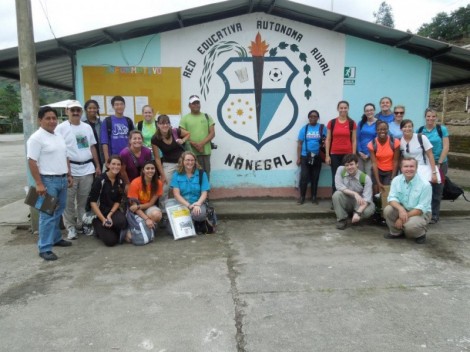Project Focus and Medical Entomology in Ecuador

By: James Cheng
After spending a few weeks traversing the Northeastern Choco-Andes rainforest corridor in Ecuador, I came back to the states a little dirty and a little worn, but also a little more “complete”.This medical entomology, plant natural history, and Project Focus study abroad trip provided an excellent way to actively learn the basics of insect collecting, birding, and real world medical and ecological applications toward humanity while also affording the opportunity to work with young rural area students on a personal level.While in Ecuador, I toured rural hospitals nestled in the tropical rainforest, interviewed and had lunch with staff from the Ecuadorian version of our Center for Disease Control, and witnessed the natural beauty of the country from the coastal beaches to the untouched rainforests along with a few more side adventures. I also experienced firsthand how the school system worked and taught young students lessons that we had prepared beforehand.
The rurally located Hospital Nanegalito was tightly snuggled in a valley between peaks of the lazy mountain ranges in the area. The hospital was in some ways, what I had envisioned a small rural hospital would be like, dimly lit, overcrowded with the ill, with dirt-caked tile floors and an aura of heaviness; yet there were also truly amazing aspects that exceeded my expectations. The hospital served the surrounding area of Nanegalito, Ecuador, which is officially responsible for providing health care to the roughly 12,000 residents of the area. However, in reality the hospital provides health care to over 45,000 patients over the course of a year with a dedicated hospital staff of only 7 internal medicine doctors, 3 specialists, and 3 dentists. Also with only a total of 15 beds, this leaves the hospital understaffed, under-equipped and truthfully, overwhelmed.
This experience into a rural hospital setting in Ecuador gave me a brief glimpse of how the healthcare system operated and a basic grasp of the conditions that the staff and patients work through. The fundamental differences between the healthcare standards of Ecuador and the United States that I had suspected were, in reality, very few. The staff was professional, the sterilization of tools was meticulous, and the pharmacy was meticulously organized. The volume of work that the staff had to handle was countered with strong leadership and a tightly organized system. The rare look into the intimate operation of a rural Ecuadorian hospital provided an heartening perspective that although the education opportunities and the resource availability was limited, the same drive to serve the community and to relieve suffering that I would expect in American healthcare was clearly mirrored in theirs.
The Project Focus portion of the program was aimed at underserved students in the younger grade levels in a total of five different communities from the mountains in the interior all the way to the coast of the Pacific Ocean. The lessons covered topics from ecosystem diversity and recognizing different bird species to fun activities of making UV-radiation sensitive bead bracelets for the young students to take home. The students in the local schools that we worked with also benefited from our presence, because our presence gave tangible evidence that there are many different cultures and places outside of their town and outside of Ecuador. Because the students had a very limited exposure to the people and cultures of those not from Ecuador, our visits enriched their cultural understanding.
Even with all these undertakings, we still found time to swim under isolated waterfalls, in smooth rainforest rivers lazily flowing with crisp water, and struggle against commanding white-capped cascades or even in the deep blue-green beaches of Mompiche. There was also time to hike miles and miles through trails less traveled in the steamy rainforests, swing in rope swings many meters high with your feet dangling over nothing but untouched forest, and time to browse the famed “leather city” and street vendors of Otavalo, Ecuador.
This study abroad trip was one that was packed with uncountable small and large experiences, and there always seems to be something lost in the translation when a third party describes a story or depicts an adventure; you often miss out on the small things. Things such as the smell of the jungle, the feel of grit between your toes, and the rolling sweat down your back provide a heightened familiarity of the lessons learned and an amplified awareness of the impact on the mind, body, and spirit. In this way, this trip to Ecuador was about more than just the eight academic credit hours that were earned and the community service rendered; it was about leaving the comfort zone of everyday life and immersing yourself in a different environment to learn from the country while also serving its community. The medical and dental professions, although seemingly straightforward, is hugely based on social and creative interactions with patients and other health care providers. With experiences in colorful backgrounds offering cultural understanding and diversifying perspectives, your education, your practice and, most importantly, your person will be enhanced.

